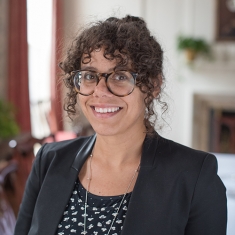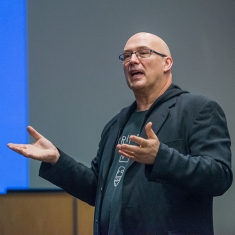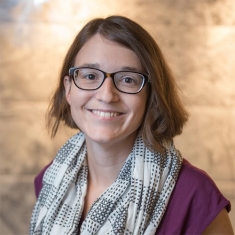Museums Concentration

The Museums Concentration gives students a foundation in the history of museums and the critical issues they engage. Through a combination of academic course work, two internships and independent research, students learn about institutions that shape knowledge and understanding through collection, preservation, interpretation and display of material culture. The Museums Concentration provides a unique opportunity at the undergraduate level for students to consider how their academic studies might connect to their future lives and careers. Students are introduced to issues such as community access, cultural ownership and public accountability—areas of study that will be important whatever they decide to do after Smith.
Announcements
Information About the Concentration
For information about the concentrations, please join us at the Presentation of the Concentrations. Register to attend.
The Museums Concentration accepts up to 15 students annually. Applications are accepted only from sophomores and juniors.Students are encouraged to apply in the fall of their sophomore year. Preference is given to students with a demonstrated interest in the application of their academic discipline to the world of museums. Eligible applicants will already have completed two of the courses on the list of required and elective courses. Some students may choose to pursue the Museums Concentration in addition to a second major or a minor when the concentration unifies and reinforces a particular program of study.
The concentration is composed of six courses, including a required gateway course, capstone seminar and four electives. The total combined coursework will accrue no fewer than 22 credits.
Gateway Course
MUX 120 ARX/BKX/MUX Gateway (offered in Spring)
This course serves as a shared gateway for the Archives, Book Studies, and Museums concentrations. Students will explore histories, futures, and systems of knowledge production, preservation, organization, and distribution through the kinds of objects and evidence held by archives, libraries, and museums. As evidence of their evolving and complex operations, this course introduces the history of such institutions, their evolving public mission, issues central to their work today, and the creation and uses of materials they hold. The course critically engages the emergence of such institutions, specifically within this regional context and in this framework of a college campus. (2 credits)
Recommended Course Electives
These are courses that have been offered over the past several years and are relevant to the Museums Concentration. Consult the course catalog for current availability. Other courses aligning with student interest and work in the Museums Concentration are eligible with adviser approval.
Students will take 4 electives—they may include up to 2 courses from a student's major and 1 from a minor.
Museums Concentration interterm course
MUX 222 Studies in Museums
What goes on behind the scenes in a museum? Who makes the decisions about what to collect and how to display and interpret it? How do concepts of mission and public trust guide that work? Through a series of rotating topics, Studies in Museums considers the conceptual and practical issues governing the work of museums. The course will use the resources of the Smith College Museum of Art—collections, programs, and staff—to explore these issues in practice. Through this work students will be introduced to the professional disciplines found within the field of museums, including curation, education, conservation, and registration.
Interterm 2023: MUX 222 Collecting and Exhibiting Asian Art: Museums as Local, National and Global Institutions As a case study, this course examines how “Asian art” has been constructed as a category and how it was/is formed and displayed in museums in and outside Asian countries. It especially pays attention to the different histories, priorities, and challenges of museums in their local, national and global contexts.
American Studies
- AMS 302 Material Culture of New England, 1630-1860
- AMS 411 American Culture - Conventions and Contexts(4 credits; open only to students in the Smithsonian Program)
Anthropology
- ANT 135 Introduction to Archaeology
- ANT 221 Archaeological Method, Theory and Practice
- ANT 249 Visual Anthropology
Archaeology
- ARC 135 Introduction to Archaeology
Art
- ARH 110 Art and Its Histories
- ARH 207 Translating New Worlds
- ARH 278 Race and Gender in the History of Photography
- ARH 280cv Visual Culture and Colonization
- ARH 288 Techniques in Digital Art History
- ARH 292 Collecting the Past: Art, Artifact, and Ancient America
- ARH 400 Special Studies
Chemistry
- CHM 100 Chemistry of Art Objects
- CHM 118 Advanced General Chemistry
- For those on a conservation track:
- CHM 111 General Chemistry
- CHM 224 Introduction to Inorganic and Physical Chemistry
Classical Languages and Literatures
- CLS 217 Greek Art and Archaeology
- CLS 218 Hellenistic Art and Archaeology
- CLS 237 Artifacts of Daily Life in the Ancient Mediterranean
Education & Child Study
- EDC 235 Child and Adolescent Growth and Development
- EDC 238 Introduction to Learning Sciences
- EDC 305 The Teaching of Visual Art in the Classroom
- EDC 347 Individual Differences Among Learners
East Asian Languages & Culture
- EAL 237 Chinese Poetry and the Other Arts
First-Year Seminars
-
FYS 197 On Display: Museums, Collections, and Exhibitions
Geology
- GEO 112: Archaeological Geology of Rock Art and Stone Artifacts
Inter/Extradepartmental
- IDP 116 Introduction to Design Thinking
- IDP 132 Designing Your Path
Landscape Studies
- LSS 245 Place Frames: Photography as Method in Landscape Studies
Latin American and Latino/a Studies
- LAS 291: Decolonize the Museum
Philosophy
- >PHI 233: Aesthetics
Psychology
- PSY 268: The Human Side of Climate Change
Theatre
- THE 154: "Reading" Dress: Archival Studies of Clothing
World Literatures
- WLT 341: Mobilities: How People, Goods, and Information Cross Borders
Five College Courses
Relevant Five College courses can also count toward Museums Concentration credit. See the current Five College catalog to check availability and consult with Museums Concentration advisers.
Overview
Course work will be complemented by at least two practical experiences within museums. These may include internships and paid or volunteer work. The elective courses combined with these practical experiences can offer you the opportunity to explore one or more specialized disciplines within the work of museums, such as curatorial practice, museum education or art conservation.
If you chose a specific area of focus for the concentration (curatorial, education, art conservation), you are encouraged to complete at least one practical experience in that area. The Lazarus Center for Career Development and the staff of the Smith College Museum of Art (SCMA) can provide information on potential museum-based work experiences, but it is your responsibility to arrange for two relevant experiences.
To count toward the Museums Concentration, an internship, volunteer or work experience must meet the requirements outlined in the next column.
As a general rule, students are encouraged to apply for Praxis funding for one of their practical experiences. Any internship that receives Praxis funding must meet separate qualifications detailed by the Lazarus Center for Career Development.
Requirements
- Consist of 150 hours of work (roughly equivalent to a year-long campus commitment or a 1-month full-time internship) or meet specific SCMA program requirements. When possible, internships of longer duration are strongly encouraged.
- Focus on substantive, content-based work.
- Receive prior approval from your Concentration adviser using the Practical Experience Pre-Approval form.
If you already completed one or more Practical Experiences before entering the Museums Concentration program, you are still eligible to receive credit for these experiences. You should complete the Pre-Approval form for each experience and review it with your adviser.
e-Portfolio
Students are required to process and reflect on practical experiences in an e-Portfolio. You will be guided through this process during several required group workshops.
The minimum expectations for what should be included in your e-Portfolio by the spring of your senior year are:
- Reflections on two specific experiences (academic or practical)
- A philosophy statement
To aid in the reflection process, students are encouraged to maintain a journal, document their practical experiences with photos and videos and to keep examples of the work and materials they produce.
The resulting e-portfolio documents students' journeys through the Museums Concentration and becomes a useful resource for seeking future experiences and jobs.
Capstone Course
MUX 300 Museums Concentration Research Capstone
This four-credit seminar is offered during the spring semester for seniors completing their culminating capstone project for the Museums Concentration. It provides a forum for students to develop the research projects that synthesize their previous coursework and practical experiences. These projects are supplemented by weekly seminar discussions during which students explore and critique the mission and work of museums and the contemporary forces that shape them. Only students participating in the Museums Concentration may register for MUX 300.
Advisory Committee
Declaration of Concentration
Students who have been accepted into the concentration and received their adviser’s name need to fill out the
→ Program of Study Declaration Form.
This is the last step in making the concentration official in Workday.
Practical Experience Forms
After discussing the proposed practical experience with their advisers, students need to fill out the corresponding practical experience approval form in order to have the experience count towards the concentration requirements:
- Summer Internship (100 hours or more) → Internship Credit Application
All students undertaking a summer internship of at least 100 hours are eligible to receive academic credit (0.25 credits per experience) that will appear on their transcript. We encourage all students who qualify to apply for internship credit. Students applying for Praxis funding don’t need to fill out this form, and should instead use the “Praxis with Credit” form below. - Unpaid Summer Internship (220 hours or more) → Praxis with Credit Application
All Smith students are eligible to receive a stipend payment for one normally unpaid internship through the Praxis program at the Lazarus Center. These internships must take place during the summer, and must comprise at least 220 working hours. Students in Concentrations are eligible to apply for Praxis a second time– Praxis Plus. When applying for a Praxis internship, the applicant must specify if the internship counts towards a concentration and should fill out the “Praxis with Credit” application. - Other Internships and Practical Experiences
Students whose internships do not meet the above requirements because they take place during Interterm, during the school year, or for any other reason, should fill out the following forms.
Prior to starting the internship please fill out the → Practical Experience Approval Form.
Upon completion of the practical experience please fill out the → Practical Experience Completion Form. - Retroactive Credit for an Experience
Students who completed a practical experience relevant to the concentration prior to being accepted into the cohort should discuss the experience with their concentration adviser as soon as possible. Once the experience is approved, students must fill out the → Practical Experience Completion Form and check the “Retroactive Experience” box on the form.
Advising Checklist for Graduation
Students are required to submit a completed Concentration Advising Checklist at the start of their final semester. This form documents the completed components of the concentration requirements, and must be signed by the student’s concentration adviser. Completed form should be sent to the registrar’s office (registrar@smith.edu) and to the administrative coordinator for concentrations (concentrations@smith.edu).
To find job and internship opportunities, check out individual museum websites. The following websites are helpful:
Overview
Museums Concentration students are eligible to apply for supplemental stipends of up to $3500 to support a summer internship or work experience to count toward their practical experience requirement. Two grants are awarded annually on a first-come, first-served basis.
Eligibility
Preference will be given to students who have already used their Praxis funding, although all Museums Concentration students who still need to fulfill the practical experience requirement are welcome to apply. A budget making a case for need should be submitted with the application. Graduating Museums Concentration students are not eligible. Students with paid work experiences are still eligible to apply for this funding to assist with living expenses, although preference will also be given to students with non-funded internships. Eligible experiences must meet the practical experience requirements.
How to Apply
Funding is contingent on submission of the Practical Experience Pre-Approval Form, which each student completes with her concentration adviser.
Deadline
Applications for grants are considered on a rolling basis. Direct questions and submit applications to Charlene Shang Miller.
Practical experiences that fulfill the requirements for the Museums Concentration are available at Smith College Museum of Art (SCMA), particularly the Student Museum Educator (SME) program which works directly and primarily with K-12 students on guided tours. SMEs also assist with various research and administrative duties in support of the museum’s education department. Ongoing yearlong training focuses on developing proficiency in gallery teaching in a supportive environment.
Requirements include:
- Participation for at least two (2) semesters
- Full attendance at training sessions
- Work at SCMA’s annual Community Day
Other substantial paid and volunteer opportunities in departments such as curatorial, collections management, and marketing and communications at the Smith College Museum of Art may be counted toward the Practical Experience requirement, pending adviser approval. Participation in the Museum Volunteer Program (MVP) or Student Museum Advisory Committee (SMAC) does not usually meet requirements for the concentration.
Paid positions are listed on JobX, the student employment site.
Museums Today programs are conversations facilitated by current Museums Concentration students with various museum professionals across disciplines and addressing a range of topics.
Regularly check this website for announcements regarding upcoming programs.
PAST PROGRAMS
Fall 2022: Conversation with Kemi Ilesanmi '98, executive director of The Laundromat Project, which advances artists and neighbors as change agents in their own communities; and nico wheadon, author of Museum Metamorphosis, in which over forty cultural innovators and changemakers in contemporary art share strategies for building sociocultural relevancy and responsiveness in museums.
Fall 2021: Conversation and workshop with MUX alumna: Olivia Feal '17, Museum Educator, Mead Art Museum at Amherst College
Spring 2021: Conversation and workshop with MUX alumna: Natalie Sandstrom '19J, Program Coordinator, Institute of Contemporary Art at University of Pennsylvania
Spring 2020: Miranda Massie, Founder and Director, The Climate Museum, New York
Fall 2019: Philip Bloom, June and Simon K.C. Li Curator of the Chinese Garden and Director of the Center for East Asian Garden Studies at the Huntington Library, Art Collections, and Botanical Gardens in San Marino, California
Spring 2019: Post-Grad Pathways with MUX Alumnae
- Jen Duckett ’14, Coordinator of School Partnerships and Teacher Programs, Museum of Fine Arts, Boston
- Beryl Briane Ford ’17, M.A. candidate, Teachers College, Columbia University
- Haley J. Graham ’16, Gallery Educator, National Portrait Gallery
- Francesca L. Lo Galbo ’12, Assistant, Creative Team, The Museum of Modern Art
Fall 2018: Frank Mitchell, Executive Director of the Amistad Center for Art & Culture, Hartford, Connecticut
Spring 2018: Panel with Museums Concentration alumnae working in a variety of museums and Rebecca Rabinow ’88, director of The Menil Collection in Houston
To apply for the Museums Concentration, fill out the online application. You may apply to the concentration in your sophomore or junior year. Application deadline for AY24 is December 1, 2023.
All accepted students are expected to attend a welcome retreat at the beginning of spring semester as well as all subsequent Museums Concentration workshops.
Can I pursue the Museums Concentration with a double major or a minor?
In some cases students may choose to pursue the Museums Concentration in addition to a second major or a minor. This would occur when the concentration serves to logically unify and reinforce a particular program of study. For example, a student with an art history major and an education minor might elect to do the minimal additional coursework for the Museums Concentration, with focus in museum education. Such decisions should be made in consultation with the student's adviser, and must be approved by the Museums Concentration Advisory Committee.
Do I need to be an art major to do a Museums Concentration?
No. The Museums Concentration has the flexibility to support any discipline relevant to museums or other kinds of collecting institutions, or it can be pursued independent of a student's major. Majors particularly compatible with the Museums Concentration include anthropology, American studies, art, chemistry, education and history. Students interested in exploring the museum applications for their discipline, such as a branch of the sciences, can choose electives to tailor their concentration.
In addition to the Smith College Museum of Art, Smith's campus includes many special collections that can provide students with valuable exposure to the work of managing collections, including the Botanic Gardens; the College Archives, the Mortimer Rare Book Room, and Sophia Smith Collection within the library, as well as other library collections; and the Historic Clothing Collection in the theater department. The diverse museums within the Five College community expand the types of institutions easily accessible to students including the Amherst College Museum of Natural History, the Emily Dickinson Museum & Homestead, the Eric Carle Museum of Picture Book Art, Historic Deerfield, Historic Northampton, and the National Yiddish Book Center, as well as the other college art museums within the Five Colleges.
If I have taken AMS 411 Exhibiting Culture: An Introduction to Museum Studies in America as part of my participation in the Smithsonian Program, can that count toward the required courses instead of MUX 118?
Yes.
If my major requires a senior research seminar can that count toward the requirement for a research capstone project for the Museums Concentration?
No. The Museums Concentration research capstone must be taken in addition to any senior research seminar required for your major.
Do the requirements for the Museums Concentration meet the preparatory requirements for admission to graduate school for study in such areas as art history, museum education, or art conservation?
No. While completing the Museums Concentration will help you prepare for graduate study in those areas, in each case there are more extensive requirements for admission to graduate school.
How will having completed the Museums Concentration help me after graduation?
The Museums Concentration provides a unique opportunity at the undergraduate level for students to consider how their academic studies might connect to their future lives and careers. Through focused practical experiences that build on what they are learning in the classroom, students will develop valuable professional skills. After investigating a variety of career paths, they will graduate with a clear understanding of their next options. Studying the complex history of museums also provides a fascinating window onto the wider world in which we live. Students are introduced to issues such as community access, cultural ownership, and public accountability—areas of study that will be important whatever they decide to do after leaving Smith.
Contact
Smith College Museum of Art
20 Elm Street
Smith College
Northampton, MA 01063
Email: museduc@smith.edu
Jessica Nicoll, Director of Museums Concentration
Charlene Shang Miller, Museums Concentration programming manager












